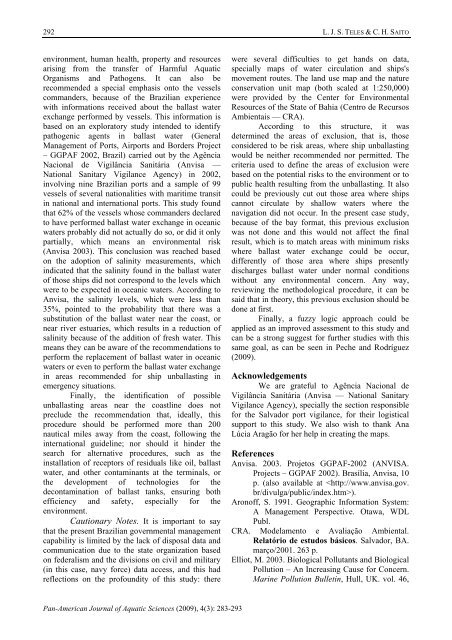Download full issue - PanamJAS
Download full issue - PanamJAS
Download full issue - PanamJAS
Create successful ePaper yourself
Turn your PDF publications into a flip-book with our unique Google optimized e-Paper software.
292<br />
L. J. S. TELES & C. H. SAITO<br />
environment, human health, property and resources<br />
arising from the transfer of Harmful Aquatic<br />
Organisms and Pathogens. It can also be<br />
recommended a special emphasis onto the vessels<br />
commanders, because of the Brazilian experience<br />
with informations received about the ballast water<br />
exchange performed by vessels. This information is<br />
based on an exploratory study intended to identify<br />
pathogenic agents in ballast water (General<br />
Management of Ports, Airports and Borders Project<br />
– GGPAF 2002, Brazil) carried out by the Agência<br />
Nacional de Vigilância Sanitária (Anvisa —<br />
National Sanitary Vigilance Agency) in 2002,<br />
involving nine Brazilian ports and a sample of 99<br />
vessels of several nationalities with maritime transit<br />
in national and international ports. This study found<br />
that 62% of the vessels whose commanders declared<br />
to have performed ballast water exchange in oceanic<br />
waters probably did not actually do so, or did it only<br />
partially, which means an environmental risk<br />
(Anvisa 2003). This conclusion was reached based<br />
on the adoption of salinity measurements, which<br />
indicated that the salinity found in the ballast water<br />
of those ships did not correspond to the levels which<br />
were to be expected in oceanic waters. According to<br />
Anvisa, the salinity levels, which were less than<br />
35%, pointed to the probability that there was a<br />
substitution of the ballast water near the coast, or<br />
near river estuaries, which results in a reduction of<br />
salinity because of the addition of fresh water. This<br />
means they can be aware of the recommendations to<br />
perform the replacement of ballast water in oceanic<br />
waters or even to perform the ballast water exchange<br />
in areas recommended for ship unballasting in<br />
emergency situations.<br />
Finally, the identification of possible<br />
unballasting areas near the coastline does not<br />
preclude the recommendation that, ideally, this<br />
procedure should be performed more than 200<br />
nautical miles away from the coast, following the<br />
international guideline; nor should it hinder the<br />
search for alternative procedures, such as the<br />
installation of receptors of residuals like oil, ballast<br />
water, and other contaminants at the terminals, or<br />
the development of technologies for the<br />
decontamination of ballast tanks, ensuring both<br />
efficiency and safety, especially for the<br />
environment.<br />
Cautionary Notes. It is important to say<br />
that the present Brazilian governmental management<br />
capability is limited by the lack of disposal data and<br />
communication due to the state organization based<br />
on federalism and the divisions on civil and military<br />
(in this case, navy force) data access, and this had<br />
reflections on the profoundity of this study: there<br />
were several difficulties to get hands on data,<br />
specially maps of water circulation and ships's<br />
movement routes. The land use map and the nature<br />
conservation unit map (both scaled at 1:250,000)<br />
were provided by the Center for Environmental<br />
Resources of the State of Bahia (Centro de Recursos<br />
Ambientais — CRA).<br />
According to this structure, it was<br />
determined the areas of exclusion, that is, those<br />
considered to be risk areas, where ship unballasting<br />
would be neither recommended nor permitted. The<br />
criteria used to define the areas of exclusion were<br />
based on the potential risks to the environment or to<br />
public health resulting from the unballasting. It also<br />
could be previously cut out those area where ships<br />
cannot circulate by shallow waters where the<br />
navigation did not occur. In the present case study,<br />
because of the bay format, this previous exclusion<br />
was not done and this would not affect the final<br />
result, which is to match areas with minimum risks<br />
where ballast water exchange could be occur,<br />
differently of those area where ships presently<br />
discharges ballast water under normal conditions<br />
without any environmental concern. Any way,<br />
reviewing the methodological procedure, it can be<br />
said that in theory, this previous exclusion should be<br />
done at first.<br />
Finally, a fuzzy logic approach could be<br />
applied as an improved assessment to this study and<br />
can be a strong suggest for further studies with this<br />
same goal, as can be seen in Peche and Rodríguez<br />
(2009).<br />
Acknowledgements<br />
We are grateful to Agência Nacional de<br />
Vigilância Sanitária (Anvisa — National Sanitary<br />
Vigilance Agency), specially the section responsible<br />
for the Salvador port vigilance, for their logistical<br />
support to this study. We also wish to thank Ana<br />
Lúcia Aragão for her help in creating the maps.<br />
References<br />
Anvisa. 2003. Projetos GGPAF-2002 (ANVISA.<br />
Projects – GGPAF 2002). Brasília, Anvisa, 10<br />
p. (also available at ).<br />
Aronoff, S. 1991. Geographic Information System:<br />
A Management Perspective. Otawa, WDL<br />
Publ.<br />
CRA. Modelamento e Avaliação Ambiental.<br />
Relatório de estudos básicos. Salvador, BA.<br />
março/2001. 263 p.<br />
Elliot, M. 2003. Biological Pollutants and Biological<br />
Pollution – An Increasing Cause for Concern.<br />
Marine Pollution Bulletin, Hull, UK. vol. 46,<br />
Pan-American Journal of Aquatic Sciences (2009), 4(3): 283-293
















